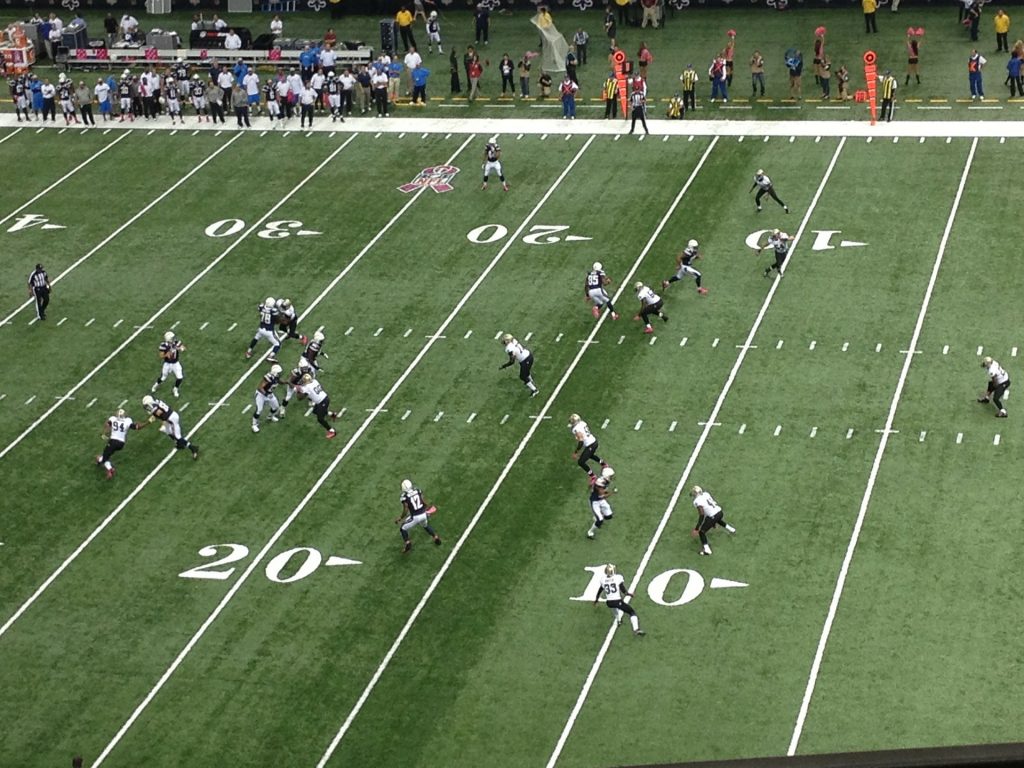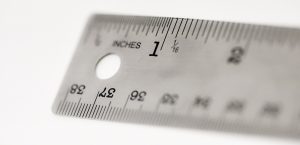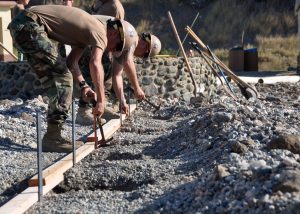2 Linear Measurements
Click play on the following audio player to listen along as you read this section.
https://video.bccampus.ca/id/0_hnr3yqhy?width=608&height=50&playerId=23448552

Linear measurement can be defined as a measure of length. The length
of a table, the length of a piece of pipe and the length of a football field are all examples of linear measurement. We might also refer to it as distance.
Linear measurements represent a single dimension. This means there is only one line or one plane being measured. Basically it means that it’s a line of some type, either straight, curved or wherever you want the line to go. It could be like a road in Saskatchewan which is long and straight or it could be a road in the interior of British Columbia which can be narrow and windy. It doesn’t matter if the item or object you are measuring is straight on not. What you are measuring will only have a length.

Measuring length can be accomplished using many different types of units. You’ve heard of a mile, foot, yard and inch but have you ever heard of a furlong, link, pole or a league? Those are all examples of imperial linear measurement.
How about on the metric side. We have the metre, the centimetre and millimetre. Those would all be familiar to us. But how about micrometre, nanometre, pentametre, tetrametre and hexametre?
How we’ll work this section is to first define metric lengths of measurement and work with them and then we’ll move onto imperial lengths of measurement and work with them. After all that is done and settled we’ll move on to working between metric and imperial.
The Metric System of Linear Measurement
If I were to ask you what is an example of a metric unit of measurement how would you respond? I think most of us might say a metre or a centimetre or even a kilometre.
One of the interesting things about the metric system of linear measurement is that it’s all based on measurements of 10 and quite often it’s referred to as a decimal based system.
For example, there are 10 millimetres in a centimetre, and there are 10 centimetres in a decimetres, and there are 10 decimetres in a metre. See the pattern. Once you get this pattern then working in metric actually becomes quite easy.
Another cool aspect to the metric system is that everything is derived from a base unit. All other units go from there using multiples of 10. Take a look at the table below to see how this works.
| Unit | Multiplier |
|---|---|
| kilometre | 1,000 |
| hectometre | 100 |
| decametre | 10 |
| metre (base unit) | 1 |
| decimetre | 0.1 |
| centimetre | 0.01 |
| millimetre | 0.001 |
The idea with the above table is that the metre is the place where all the other numbers work back to. So, for example, to go from kilometres back to metres we would multiply by 1000. If we had a length of one kilometre that means we would have a length of 1000 metres.
If we were to go from centimetres to metres the chart tells us that a centimetre is 1/100 of a metre. Therefore if we had one centimetre we would multiply that by 0.01 to get metres.
You might be wondering at this point whether that is all there is to the metric system of linear measurement. In fact there are a number of other measurements based on the metre. Take a look at the crazy table below to see how far the measurement spreads out from the metre.
| Common metric prefix | Multiplier |
|---|---|
| yotta | 1,000,000,000,000,000,000,000,000 |
| zetta | 1,000,000,000,000,000,000,000 |
| exa | 1,000,000,000,000,000,000 |
| peta | 1,000,000,000,000,000 |
| tera | 1,000,000,000,000 |
| giga | 1,000,000,000 |
| mega | 1,000,000 |
| kilo | 1,000 |
| hecto | 100 |
| deca | 10 |
| metre (base unit) | 1 |
| deci | 0.1 |
| centi | 0.01 |
| milli | 0.001 |
| micro | 0.000001 |
| nano | 0.000000001 |
| pico | 0.000000000001 |
| femto | 0.000000000000001 |
| atto | 0.000000000000000001 |
| zepto | 0.000000000000000000001 |
| yocto | 0.000000000000000000000001 |
 Do you recognize any of these prefixes? You might see some of the larger ones such as mega, giga and terra used in computers when dealing with memory and speed.
Do you recognize any of these prefixes? You might see some of the larger ones such as mega, giga and terra used in computers when dealing with memory and speed.
Don’t worry though as we will generally never work with a lot of these in the trades and we will be sticking to the few that surround the metre.
What we want to do now is to work within the metric linear system. We want to be able to go from one unit of measurement to another and we will utilize the two tables up above for this.
Example
How many centimetres are there in 2.3 metres?
[latex]\Large2.3 \text{ metres}= \text{X centimetres}[/latex]
Similar to how we did things in the first four chapters we will go about this in steps.
Step 1: Find the multiplier
What we see is that going from centimetres to metres the multiplier is 0.01. What this is saying is a centimetre is 1/100th of a metre or that there are 100 centimetres in a metre.
It’s important here to note that a centimetre is smaller than a metre and as this is the case then we would expect our answer to decrease.
Step 2: Build a ratio
[latex]\Large \dfrac{1\text{ m}}{2.3\text{ m}} = \dfrac{100\text{ cm}}{\text{X cm}}[/latex]
What this ratio states is that if 1 metre is equal to 100 centimetres then 2.3 metres is equal to X centimetres.
Step 3: Cross multiply.
[latex]\Large \begin{array}{c} \dfrac{1\text{ m}}{2.3\text{ m}} = \dfrac{100\text{ cm}}{\text{X cm}} \\ 1 \times \text{X} = 2.3 \times 100 \\ \text{X}=230 \\ \text{Answer}= 230\text{ centimetres}\end{array}[/latex]
We’ll try another example.
Example
How many kilometres are there in 1057 metres?
Step 1: Find the multiplier.
[latex]\Large\text{multiplier} = 1000[/latex]
[latex]\Large1 \text{ kilometre} = 1000 \text{ metres}[/latex]
Step 2: Build a ratio
[latex]\Large\dfrac{1 \text{ km}}{\text{X km}} = \dfrac{1000 \text{ m}}{1057 \text{ m}}[/latex]
Step 3: Cross multiply.
[latex]\Large\begin{array}{c} \dfrac{1 \text{ km}}{\text{X km}}= \dfrac{1000 \text{ m}}{1057 \text{ m}} \\ 1\times 1057 = \text{X} \times 1000 \\ \text{X} = \dfrac{1057}{1000}=1.057 \\ \text{Answer} = 1.057 \text{ metres}\end{array}[/latex]
Practice Question
Try a couple practice questions yourself and check the video answers to see how you did. Make sure to follow the steps outlined above and think about whether your answer should be bigger or smaller.
Question 1
 Barry owns a sheet metal company (Metal Sheet Incorporated) and he is making duct work for a heating system in a new video production studio under construction. The ducts are 0.79 metres wide by 0.45 metres deep. What is the depth of the ducts in centimetres?
Barry owns a sheet metal company (Metal Sheet Incorporated) and he is making duct work for a heating system in a new video production studio under construction. The ducts are 0.79 metres wide by 0.45 metres deep. What is the depth of the ducts in centimetres?
https://video.bccampus.ca/id/0_ophwpsky?width=608&height=402&playerId=23448552
The Imperial System of Linear Measurement
The imperial system isn’t quite as straight forward as the metric system. If we were to try and follow the same principle as the metric system we would think that 1 foot would be equal to 10 inches but unfortunately it’s not. One foot is equal to 12 inches and one mile is equal to 5280 feet.

Any guesses why there are 5280 feet in a mile? It turns out that it stems from an ancient linear measurement used by the Romans. Back then one mile was equal to 5000 Roman feet. Then the British started using it and decided to relate it to what worked for them which was agriculture. In agriculture they liked to use furlongs as their length of measurement. A furlong was 660 feet and one mile was decided to have 8 furlongs. Well 8 times 660 is equal to 5280 feet.
A foot also has a historical significance and if you guessed that it was based on an average human foot you would be right. There are some who believe that it is actually based on the average human shoe length. Either way naming it a foot makes sense.
Take a look at the table below to get an idea of how the imperial system of linear measurement works.
| Unit Name | Equivalent Values |
|---|---|
| Inch | 0.083 feet. 0.028 yards |
| foot | 12 inches, 0.333 yards |
| yard | 3 feet, 36 inches |
| fathom | 6 feet, 72 inches |
| rod | 5.50 yards, 16.5 feet |
| furlong | 660 feet, 220 yards, 1/8 mile |
| mile | 5280 feet, 1760 yards, 320 rods |
| Nautical mile | 6,076 feet, 1.151 miles |

At first glance this may seem a little more confusing than metric and realistically if we were dealing with all those different length measurements it just might be. Lucky for us we are only going to deal with 3 of the measurements for the most part. Those three include inches, feet and miles. Once in a while we might see yards come in to play. For instance an American football field is 100 yards long and 120 if you include the 2 end zones.
Once again our task it to work within the imperial system and be able to work between values. Before we start I want to remind you to think about the answer you are trying to find. What I want you to think about is whether or not the answer is going to be bigger or smaller.
An example would be feet to inches. If we were to cut a piece of pipe 2 feet long do you think it would this end up being more than 2 inches long or less than 2 inches long. I think we all agree that it would be more than 2 inches and in fact it is. It works out to be 24 inches. You might not be able to get 24 inches right away but you probably can figure out that 2 feet stated in inches should work out to be a greater number.
Let’s use that as our first example:
Example
How many inches are there in 2 feet?
Step 1: Find the number that states the relationship between inches and feet.
In this case:
[latex]\Large1\text{ foot}= 12 \text{ inches}[/latex]
Step 2: Build a ratio
[latex]\Large\dfrac{1 \text{ foot}}{2 \text{ feet}}=\dfrac{12 \text{ inches}}{\text{X inches}}[/latex]
Step 3: Cross multiply
[latex]\Large\begin{array}{c}\dfrac{1 \text{ foot}}{2 \text{ feet}}=\dfrac{12 \text{ inches}}{\text{X inches}} \\ 1\times \text{X} = 2 \times 12 \\ \text{X} = 24 \\ \text{Answer} = 24 \text{ inches}\end{array}[/latex]
Although you might have been able to do that in your head, it’s important to follow the steps involved and think about the answer you expect to get. This will help when the numbers are more involved and not as easy to figure out.
Example
How many yards are there in 247 inches?
Step 1: Find the number that goes between yards and inches. Note that there are actually 2 numbers here to choose from. We could use:
[latex]\Large 1 \text{ yard} = 36 \text{ inches}[/latex]
[latex]\Large \text{OR}[/latex]
[latex]\Large 1 \text{ inch}= 0.028 \text{ yards}[/latex]
In this question we are going from inches to yards so working with the number 0.028 will be easier for us.
Step 2: Build a ratio
[latex]\Large\dfrac{ 1 \text{ inch}}{247 \text{ inches}}= \dfrac{0.028 \text{ yards}}{\text{X yards}}[/latex]
Step 3: Cross multiply
[latex]\Large\begin{array}{c}\dfrac{ 1 \text{ inch}}{247 \text{ inches}}= \dfrac{0.028 \text{ yards}}{\text{X yards}} \\ 1 \times \text{X} = 247 \times 0.028 \\ \text{X}= 6.916 \\ \text{Answer} = 6.916 \text{ yards}\end{array}[/latex]
Practice Question
Try a practice question yourself and check the video answers to see how you did. Make sure to follow the steps outlined above and think about whether your answer should be bigger or smaller.
Question 1
 The length of the duct work that Barry, our sheet metal tradesperson, has to create for the video production studio is 193 yards. How many feet of the duct does Barry have to order to complete the job?
The length of the duct work that Barry, our sheet metal tradesperson, has to create for the video production studio is 193 yards. How many feet of the duct does Barry have to order to complete the job?
https://video.bccampus.ca/id/0_7u6yny1x?width=608&height=402&playerId=23448552
Working between the Metric and Imperial Linear Measurements Systems

What happens when we have to work between the metric and imperial systems? It really works just the same but we need to learn a few new numbers.
The table below is a list of numbers which can be used to help translate between metric and imperial linear measurements. What you’ll note here is that the equivalent numbers represent units that are similar in length (or used similarly) in different situations.
An example would be kilometres and miles. Both are used to represent such things as distance travelled in a car, train, bus or airplane. We don’t go and measure those long distances using centimetres or its imperial equivalent which is inches. That just wouldn’t be convenient.
Likewise if we were to measure the length of a house we would most likely use the metres or its imperial equivalent which is feet.
Also note that we don’t translate every metric and imperial number to their equivalents. As we won’t be working with most of the units there is no real need to find all these numbers. Having said that, if you wanted to go through and find the numbers yourself on the internet or possibly even try and figure them out using the numbers in the tables above and below then it would most likely help with your understanding of how linear measurement units work with each other.
| Metric | Imperial Equivalent |
|---|---|
| 1 metre | 3.28 feet |
| 1 kilometre | 0.62 miles |
| 1 centimetre | 0.393 inches |
| 1 millimetre | 0.0394 inches |
It might also be helpful to look at those numbers in the reverse.
| Imperial | Metric Equivalent |
|---|---|
| 1 foot | 0.305 metres |
| 1 mile | 1.61 kilometres |
| 1 inch | 2.54 centimetres |
| 1 inch | 25.4 millimetres |

Even though we have a conversion number to go from miles to kilometres, and then a conversion number to go from kilometres to miles, we don’t actually have to remember both.
Whichever of the two numbers is easiest for you to remember is all you need to memorize. Once you know one you can get the other.
Here’s how it works.
We’ll use miles and kilometres for this exercise. What we know is that 1 mile is equal to 1.61 kilometres.
[latex]\Large 1 \text{ mile} = 1.61 \text{ kilometres}[/latex]
Now what we need to figure out is the reverse. In this case how many miles there are in one kilometre. Once again ask yourself whether you think the answer should be bigger or smaller than 1.
So to figure out our answer we need to do the following.
[latex]\Large\begin{array}{c} \# \text{ kilometres} = \# \text{ miles} \times 1.61 \\ \downarrow \\ \# \text{ miles} = \dfrac{\# \text{ kilometres}}{1.61} \\ \downarrow \\ 1 \text{ mile} = 0.62 \text{ kilometres}\end{array}[/latex]
So we end up with 1 kilometre equaling 0.62 miles.
We’ve just taken one constant to derive the other constant. You can do this with any of the numbers used to translate back and forth between metric and imperial.

Let’s move on. Now what we will do is start to work between the imperial and metric systems and the easiest way to do this is by going through some example questions.
Example
How many metres are there in 42 feet?
Step 1: Find the number you can work with.
We know that:
[latex]\Large\begin{array}{c} 1\text{ metre} = 3.28 \text{ feet} \\ 1 \text{ foot} = 0.305 \text{ metres}\end{array}[/latex]
As we are going from feet to metres we’ll go with 1 foot = 0.305 metres.
Step 2: Build a ratio
[latex]\Large \dfrac{1 \text{ foot}}{42 \text{ feet}}= \dfrac{0.305 \text{ metres}}{\text{X metres}}[/latex]
Step 3: Cross multiply
[latex]\Large\begin{array}{c} \dfrac{1 \text{ foot}}{42 \text{ feet}}= \dfrac{0.305 \text{ metres}}{\text{X metres}} \\ 1\times \text{X} = 42 \times 0.305 \\ \text{X} = 12.81 \\ \text{Answer} = 12.81 \text{metres}\end{array}[/latex]
Example
How many inches are there in 100 centimetres?
Step 1: Find the number you can work with.
We know that:
[latex]\Large\begin{array}{c} 1 \text{ centimetre}= 0.393 \text{ inches} \\ 1 \text{ inch} = 2.54 \text{ centimetres}\end{array}[/latex]
As we are going from centimetres to inches we’ll go with 1 centimetre = 0.393 inches
Step 2: Build a ratio
[latex]\Large \dfrac{1 \text{ cm}}{100 \text{ cm}}=\dfrac{0.393 \text{ in}}{\text{X in}}[/latex]
Step 3: Cross multiply
[latex]\Large\begin{array}{c} \dfrac{1 \text{ cm}}{100 \text{ cm}}=\dfrac{0.393 \text{ in}}{\text{X in}} \\ 1 \times \text{X} = 100 \times 0.393 \\ \text{X} = 39.3 \\ \text{Answer} = 39.3 \text{cm}\end{array}[/latex]
Practice Questions
Try a couple practice question for yourself. Make sure to go through the steps similar to the example questions above and also make sure to check the video answers to see if you are correct.
Question 1

Jakob is a carpenter who creates forms for concrete columns. The measurements for the column are in millimetres but Jakob would rather work in inches so he decides to translate the millimetres to inches. The columns are rectangular and are 400 mm by 250 mm. What are the measurements of the column in inches?
https://video.bccampus.ca/id/0_hw8h23wb?width=608&height=402&playerId=23448552
Question 2

Elias is a cabinetmaker from Sweden who is now an apprentice in Canada. He has been asked to order material for the job and it totals 427 feet of 1″ x 4″ wood. As he is used to working in metric he wants to change that to metres. How many metres of 1″ x 4″ is he going to need?
https://video.bccampus.ca/id/0_rhstpyfy?width=608&height=402&playerId=23448552

